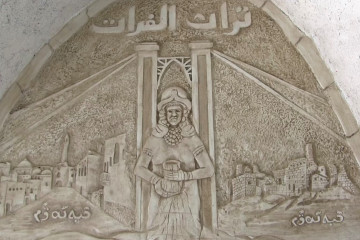

Over one thousand hours of video content featuring musicians, storytellers, poets, farmers and fishermen ensure that the vulnerable cultural heritage of the Euphrates will be documented and preserved.
The videos, which have attracted over seven million views on Facebook in Syria and Iraq, have been produced by the Heritage of the Euphrates initiative.
The project aims to record and celebrate the poetry, music and storytelling traditions of the people and places along the Euphrates River Valley.
"Much of the content is concerned with a shared history of the region going back to ancient Mesopotamia"
It is affiliated to Eye on Heritage, a UK based heritage organisation founded by archaeological researcher Augustus Lersten and producer, curator and photographer Richard Wilding to help local teams document and preserve intangible cultural heritage in conflict and post-conflict regions.
“Augustus and I first met three years ago,” says Wilding. “We realised that we shared an interest in the heritage of the Middle East, and also a desire to work directly with filmmakers in the region to record and protect intangible cultural heritage (living culture such as music and poetry as distinct from more static heritage such as architecture).
"We wanted to use the power of social media and digital distribution to help filmmakers from the region reach an international audience, and also connect with local audiences engaged in heritage and heritage protection outside of the Western academic context.
“We have supported projects in Syria, Iraq and Afghanistan in which teams of filmmakers have documented heritage made vulnerable by war, sectarianism, forced migration and deliberate campaigns of suppression.”
Eye on Heritage has helped establish two ‘heritage houses’ for the planning, filming, editing and distribution of videos. The first opened in 2019 as a media centre and operational base for the Heritage of the Euphrates project.
Although established and operated by Syrian refugees from the Deir Ez-Zor province, it is located over the border in Urfa (Şanlıurfa), Turkey. A central iconic feature inside the building, also serving as a backdrop for video productions, is a large relief artwork created by Syrian artists. It depicts heritage from around Deir Ez-Zor, incorporating artistic motifs and symbols from the pre-Islamic, Islamic and modern eras.
“The team based in Urfa has been working in close coordination with their friends and colleagues in the towns and villages throughout the Deir Ez-Zor governorate filming its heritage, music, poetry and also other aspects of life such as agriculture, linguistics, farming and games,” says Lersten.
“They have also conducted numerous interviews with former and current inhabitants of Deir Ez-Zor in which they describe their feelings about their local history, tribal and ancestral traditions and also everyday issues such as the current mark-up on the price of fish by brokers and middlemen.”
The project has grown from strength to strength and a second heritage house was established in Raqqa, Syria at the beginning of 2021.
“We felt it was important and symbolic to set up something in Raqqa, which had previously been the Islamic State group (IS) capital,” says Wilding. “It is a town that has suffered greatly and most of the buildings were damaged or destroyed. Every building bears an imprint of the recent conflict.”
Facebook is the primary broadcast platform for the project. It also has a YouTube channel with videos ranging from two to thirty minutes in length. In just four weeks from mid-October to mid-November 2021, the local production teams in Syria uploaded 135 videos.
"This initiative is partly a reaction to the threat caused by the civil war in Syria and cultural destruction under IS, but it is also looking to the future, helping to continue important oral traditions that could die out"
“This is not work that has been directed by us,” explains Wilding. “This is the output of a fully-fledged production team working on the planning, filming, editing and publishing of videos. It has taken on a life of its own.
“We feel it is important to stress firstly that this is not an exhibition. We do not have a team that creates content, hands it over and then that is it. It is an ongoing project, growing organically. Secondly, we have a community that exists both physically as a network in Syria and also online in the form of a Facebook page that reaches an audience of millions. Thirdly, the themes that we explore are not limited to Syria.
"Much of the content is concerned with a shared history of the region going back to ancient Mesopotamia. And lastly, this initiative is partly a reaction to the threat caused by the civil war in Syria and cultural destruction under IS, but it is also looking to the future, helping to continue important oral traditions that could die out.”
Wilding and Lersten speak about the need to evolve with the latest technology and the logistical challenges involved in working with their colleagues in Syria.
The project is still in an embryonic stage and will need external funding to grow and develop. Wilding and Lersten are hoping to raise funds to allow the purchase of more equipment, to enable the translation and subtitling of videos to reach a wider international audience and the establishment of a third heritage house in Deir Ez-Zor.
This would allow the Heritage of the Euphrates initiative to cover the entire length of the Euphrates in Syria, from Urfa (on the Turkish border) to Raqqa (centre) and Deir Ez-Zor (south).
Karen Dabrowska is a London-based freelance journalist focusing on the Middle East and Islamic Affairs. She is also the author of ten books. Her latest, biography, Mohamed Makiya: A Modern Architect Renewing Islamic Tradition was published by Al-Saqi in July.
Follow her on Twitter: @KarenDabrowska1
![Discussion and interview by the banks of the Euphrates [Heritage of the Euphrates Valley]](/sites/default/files/styles/medium_16_9/public/2021-12/%285%29%5B7793%5D.jpg?h=7b436a88&itok=-Tm35prS)






 Follow the Middle East's top stories in English at The New Arab on Google News
Follow the Middle East's top stories in English at The New Arab on Google News


